Bringing a Community Together with Octavia Butler
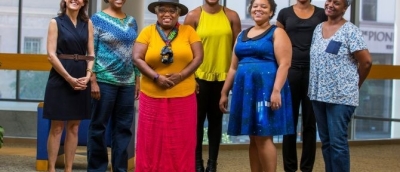
By Jessica Pryde, Pima County Public Library
The Black population in Pima County is small: 3.5 percent of a million-plus population across 9,189 miles small. It’s been around since the establishment of Tucson and the settlements in the Catalina Foothills just north of the city. The Dunbar neighborhood, home to the historic Dunbar School and now host of an ever-blossoming cultural center, was one of two neighborhoods in Tucson where Black residents were allowed to own property in the early days of the city’s existence. Its tendency to flood and distance from the University of Arizona left it less than desirable to other residents.
While smaller even than the total percentage of Black residents in the whole of Arizona, the Black population in the county has been growing, particularly around the epicenter of the Davis-Monthan Air Force Base, and with the presence of companies like Raytheon and Caterpillar. As Tucson spreads and Pima County’s suburban and rural populations see growth, so does the Black population. But the Black community in Pima County is splintered, and the non-Black populations both within and outside of the county are less aware of not just its history, but its continued presence from Tucson’s Spanish Wild West days to the present.
How could Pima County Public Library support and strengthen this growing community? For me, it started on an elevator. I rode down from the administration level at the Joel D. Valdez Main Library to the parking garage with Amy Rusk. She proposed an idea to me that she had already discussed with other library staff.
What could a small group of six do to reach younger staff, to encourage them to become librarians and take positions of leadership within our organization?
Amy, a library services manager for public service, is devoted to upholding the library’s values of diversity and inclusion. She was already involved in Pima County Public Library’s Nuestras Raíces and Welcome to America teams, supporting Latinx and immigrant and refugee communities, respectively, in Pima County. And now, it was within everyone’s interest, she said, to pull together a collective of Black library workers – a Black Caucus, as it were. In fact, it was imperative, in order to assess Pima County Public Library’s involvement in the Black community and the organization’s engagement with, and support of, Black Pima County residents, both on staff and outside the library.
At the time, there were only two Black librarians — both at the lowest tier of librarianship, Librarian I. All of the other Black staff members (out of a total of 650 staff) were in paralibrary positions, many part-time or intermittent. Even with a complete assessment of library staff demographics, we did not match the county as a whole.
So what could we do about staffing? What could a small group of six (Amy, Angela, Dana, Debbi, Tenecia and myself) do to reach younger staff, to encourage them to become librarians and take positions of leadership within our organization? What changes could we make to the library as a whole in order to reach more of the Black community, at all the levels and in all of the communities that we weren’t yet reaching? What could we do to actualize the Mission of the Pima County Public Library — to transform lives by educating, inspiring and connecting people?
And thus, Kindred was born.

It didn’t take long to establish our goals:
- To help the working population at Pima County Public Library reflect the current demographics of Pima County
- To improve Black representation in Pima County Public Library at all levels and all branches
- To educate library staff in order to change the work culture and environment
- To help break down preconceived ideas and prejudice about the Black community as a whole and Black people individually
- To connect with the Black community by creating programming and enhancing the collection for their needs and interests
- To promote the goals and desires of the Black community in order to elevate ownership and buy-in
- To make the official Pima County Public Library diversity statement true in practice
We synthesized all of this into a single mission statement: to reach, celebrate and support the Black community.
Motivated to reach our goals, we got to work.
A tenacious group who love the library and the community as a whole, we have a lot of plans. Our first big project is One Book, One Community, built out of an inkling after a long, delightful conversation about Octavia Butler.
One of our first steps was to develop a few partners in the community. Shortly after we formed, Kindred found ourselves in contact with Dr. Monica Casper, who is currently the associate dean for faculty affairs and inclusion in the College of Social and Behavioral Sciences at the University of Arizona. She and her colleague Stephanie Troutman, assistant professor in emerging literacies, joined us for a round-table discussion on potential partnership at the University of Arizona. Through a sharing of plans and ideas, we landed on Octavia Butler. The pair were working on a Humanities Seminar — a course designed for members of the community — around Butler, and were looking at long-term programming on campus to celebrate her life and work. We all took a moment to sigh over Butler’s lush writing, her keen eye and unfortunate foresight into a future that could be coming any moment. But we kept coming back to this idea of a One Book project, and when it was time to plan on Kindred’s end, that’s where we arrived.
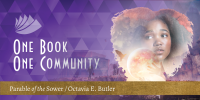
Looking back, it might have made more sense to make Kindred the first book in this project, but we chose Parable of the Sower. Not only was it a timely choice — 2018 marked the book’s 25th anniversary — but the themes presented by protagonist Lauren and her compatriots on her journey are just as meaningful today as they were in 1993. What better way to unite diverse communities than through an amazing piece of literature?
So how, exactly, do we unite people through a book? Instead of selecting a book that we would only have limited copies of for use with a library card, or requiring community members to buy a book, we opted to apply for a mini-grant, funded by the Institute of Museum and Library Services (IMLS) via the Library Services and Technology Act (LSTA). This would provide a small amount of money (in the grand scheme of things) for books to provide to the community, free of charge, as well as a limited number of discussion guides. With that kind of base, we could really develop the program around guided discussion across the library system. There would still be copies in other formats to read through the library with a library card. But the important part was reach. What better way to start the conversation with the community, especially those who didn’t frequent the library as often as they could, than to give them a book they didn’t have to bring back? And boy, the conversations that could be had around Parable. Lauren’s tenets of change. The kinds of people you meet on a long journey. The elements of a society that can lead to its downfall. These are just a few of the things we wanted people to think about when reading the book.
What better way to unite diverse communities than through an amazing piece of literature?
Once we had a written plan, there was paperwork. Internally, teams looking to start a new project have to produce a project planner, which breaks down intent and impact, both on staff and the community. Once the planner is approved, the team can go about starting the official paperwork. In this case, members of Kindred attended workshops on how to apply for LSTA grants, and then submitted a grant proposal to the Pima County Public Library Executive Team. Once we received approval, we pressed send, and off our application went to the Arizona State Library, Archives and Public Records for consideration.
Now, it was time to wait. In the meantime, we began working on logistics. Book distribution points, ratio of books to reading guides, discussion planning.
We decided on a mixed grouping of libraries in different locations and of different sizes and demographic representation. After much thought and back-and-forth, we eventually decided to offer conversations on the book in two halves, with options to attend discussions around the book in its entirety. We all agreed: it was a rough book to get through, and some people might not want to dive into it all at once. The writing itself was dense and intense, and the subject matter wasn’t always easy to read. Also, two meetings offered more opportunity to do a deep dive, and have the kinds of conversations four whole hours could provide, with time to dig into each question beyond the surface.
In the end, we had an amazing product that we were happy to distribute to all of our libraries, to our media partners and on social media.
We waited to meet with the community relations and visual marketing managers until the money was in our hands, at which point we could start moving with promotion, talking points and all the bells and whistles that go with the first-ever project of this kind for this community. Holly Schaffer, our community relations manager, worked with the team to produce a press release and spark interest in the local media, leading to coverage by local news and public radio. We were very deliberate regarding who we wanted to reach, which avenues of coverage we wanted to take. In order to ensure that we were reaching not only the middle-class to affluent, mostly white population that marks more than half of the county’s population, but also the communities of color — both younger and older; working-class to affluent themselves — that may or may not frequent the library. We considered which media outlets were best to push and which were nice, but not necessary. Holly had some great input on the demographic reach of so many of our media partners, and we were happy to find channels to reach our desired audience. Reneé Bibby, our visual marketing manager, worked extensively to come up with the right branding for our promotional materials — print and online — and consulted with us on the right colors, imagery and context for the book and the project as a whole. In the end, we had an amazing product that we were happy to distribute to all of our libraries, to our media partners and on social media.
We haven’t completed the process, but the word is out there. Community members have shared photos displaying their copies of the book and study guide — along with the bookmark — on social media. Staff and community members are excited and telling friends word-of-mouth about the book discussions. By the time we’re done, we will have had 14 in-person discussions (two about the whole book) and two Twitter chats using the hashtag #KindredOBOC.
With One Book, One Community as a first project, Kindred is definitely making strides to reach the external part of our ongoing goals. The community isn’t just coming together to discuss a timeless book by an exceptional Black author; they’re coming together to embrace each other.
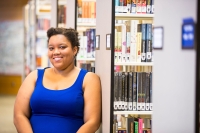
Jessica Pryde is the digital literacy and learning librarian at Pima County Public Library. In addition to serving on Kindred, Jessica is an active member of the library’s LGBTQ+ and Ravenous Readers teams and she volunteers as the Tucson Festival of Books social media representative. In her spare time, she is happily reading everything under the sun. She tries to keep up by having either a paper book, ebook or audiobook at her fingertips at all times, but the books, they just keep coming.
Related Articles
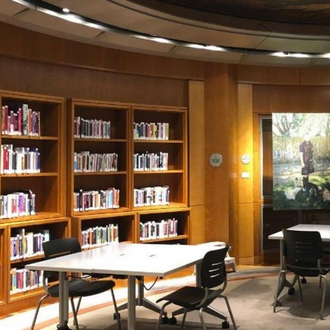
Strengthening Representation of LGBTQIA People of Color
Learn how San Francisco Public Library's Hormel Center is expanding scholarship and representation of LGBTQIA people of color.
Learn how San Francisco Public Library's Hormel Center is expanding scholarship and representation of LGBTQIA people of color.
Learn More
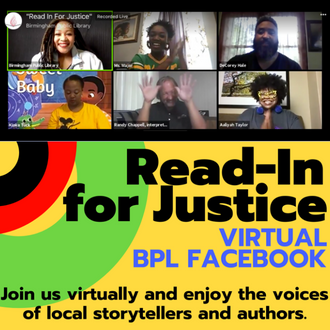
Birmingham's Read-in for Justice
Birmingham Public Library
Discover how Birmingham Public Library put together an event to resonate the voices of local storytellers and authors to share books by people of color.
